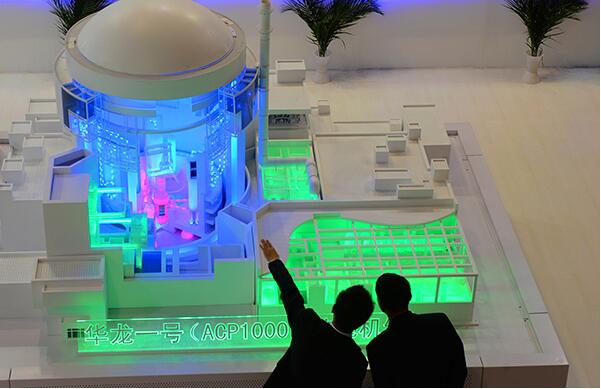


A model of Hualong One nuclear reactor. File photo.
“We have drawn on global experience over the years, and have integrated advanced design concepts including AP1000 and EPR to ensure the safety of the Hualong One nuclear project. The reactors can even withstand a tsunami of the strength that triggered Japan’s Fukushima disaster,” said Xue Junfeng, vice chief engineer of China's Hualong One reactors.
Two nuclear facilities using Hualong One technology, a domestically developed third-generation reactor design, are under construction at the site of the Fuqing nuclear plant in eastern China’s Fujian province. The construction is on schedule, with the plant slated to begin operation by 2020.
The reactors are made in accordance with the world’s top safety standards. They are able to withstand a level 17 typhoon, a magnitude 9 earthquake and the force of a collision with a commercial airplane. The reactors can also activate a series of protective measures when external power is cut off, according to Chen Guocai, vice chief manager of Fujian Fuqing Nuclear Power Co. Ltd., affiliated with China National Nuclear Corporation (CNNC).
The Hualong One reactors are fully compliant with all safety standards set by the International Atomic Energy Agency, making them suitable to be sold outside of China. More than 20 countries, including Britain, Argentina, Egypt and Pakistan, have signed agreements with China to adopt Hualong One technology.
The Hualong One reactor was jointly designed by two nuclear power giants, China General Nuclear Power Group and CNNC. It passed inspection by a national expert panel in August 2014. In November 2014, the National Energy Administration approved the use of Hualong One technology to build two reactors in Fujian province. The State Council approved the construction in April 2015.
 Fire brigade in Shanghai holds group wedding
Fire brigade in Shanghai holds group wedding Tourists enjoy ice sculptures in Datan Town, north China
Tourists enjoy ice sculptures in Datan Town, north China Sunset scenery of Dayan Pagoda in Xi'an
Sunset scenery of Dayan Pagoda in Xi'an Tourists have fun at scenic spot in Nanlong Town, NW China
Tourists have fun at scenic spot in Nanlong Town, NW China Harbin attracts tourists by making best use of ice in winter
Harbin attracts tourists by making best use of ice in winter In pics: FIS Alpine Ski Women's World Cup Slalom
In pics: FIS Alpine Ski Women's World Cup Slalom Black-necked cranes rest at reservoir in Lhunzhub County, Lhasa
Black-necked cranes rest at reservoir in Lhunzhub County, Lhasa China's FAST telescope will be available to foreign scientists in April
China's FAST telescope will be available to foreign scientists in April "She power" plays indispensable role in poverty alleviation
"She power" plays indispensable role in poverty alleviation Top 10 world news events of People's Daily in 2020
Top 10 world news events of People's Daily in 2020 Top 10 China news events of People's Daily in 2020
Top 10 China news events of People's Daily in 2020 Top 10 media buzzwords of 2020
Top 10 media buzzwords of 2020 Year-ender:10 major tourism stories of 2020
Year-ender:10 major tourism stories of 2020 No interference in Venezuelan issues
No interference in Venezuelan issues
 Biz prepares for trade spat
Biz prepares for trade spat
 Broadcasting Continent
Broadcasting Continent Australia wins Chinese CEOs as US loses
Australia wins Chinese CEOs as US loses